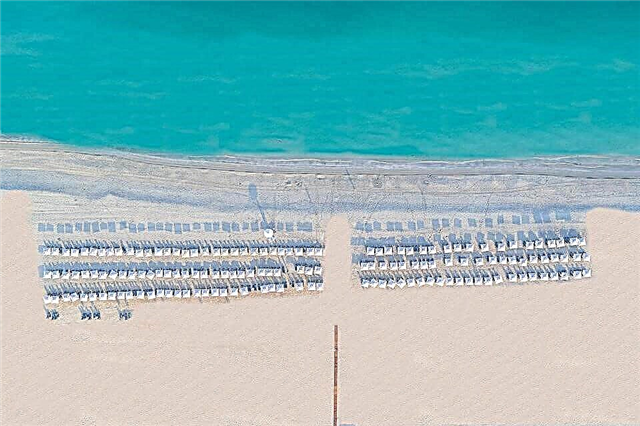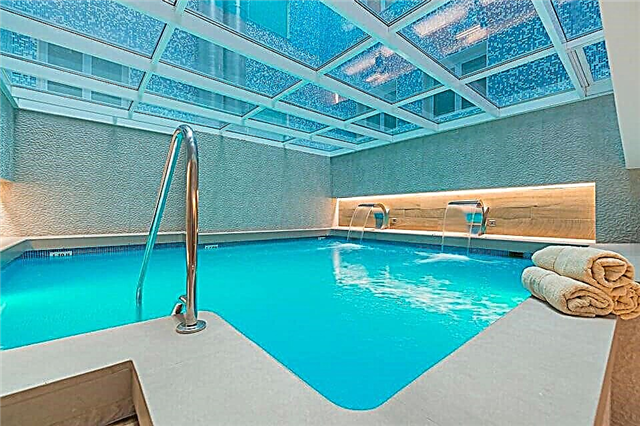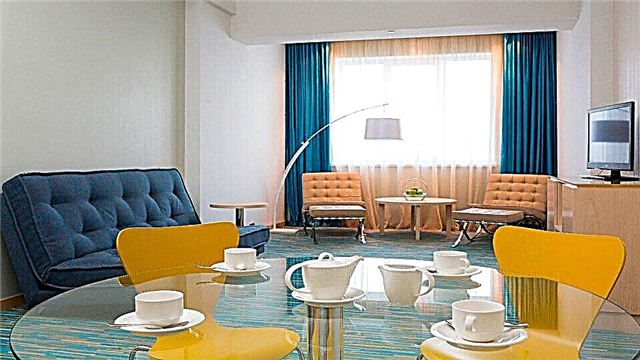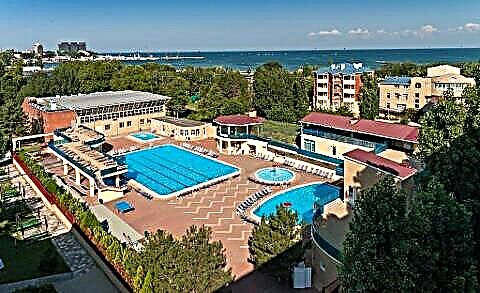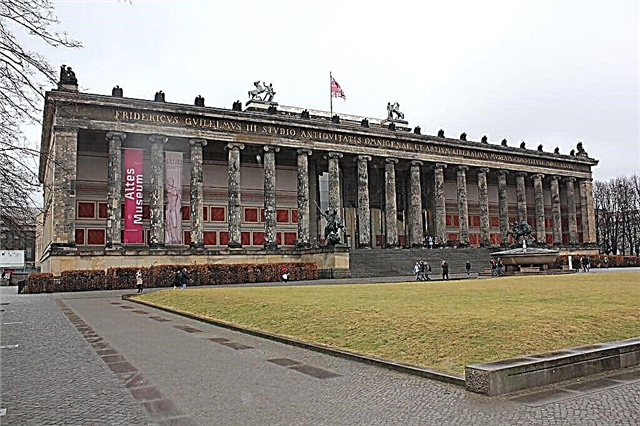Museum Island in Berlin - a picturesque corner of the northern tip of the Spreinsel Island, surrounded by the waters of the Spree River, attracts tourists, a bright constellation of unique museums with a huge collection of masterpieces of world art. Such a number of museums, collected on a small island patch, is not found in the whole world. History testifies that the construction of the museum complex, included in the UNESCO World Cultural Heritage List, lasted 100 years.
History

The area, now called Museum Island, was a real swamp in the 13th century. Two centuries later, several canals were laid from the bend of the Spree River, draining the swampy area. In the 19th century, the idea of creating a cultural center of Berlin on this site took possession of Emperor Wilhelm II, who ruled the country. He supported the plan proposed by the archaeological scientist Alois Hirt to build a gallery on the island, where the artifacts and works of modern art collected during archaeological excavations were to be displayed for people to see.
The beginning was laid with the construction of the Old Museum, which opened its storerooms to the townspeople in 1830. After 29 years, the opening of the New Museum took place, and in 1876 visitors saw the picturesque masterpieces in the Old National Gallery. At the beginning of the twentieth century, the grandiose cultural construction continued. The Monbijou bridge was extended to the island, and the building of the museum, later named after the art critic Bode, was added to the museum complex. 1930 marked the 100th anniversary of the founding of the Museum Island with the presentation of the Pergamon Museum. Since then, art lovers have called the German capital "Athens on the Spree".
Unrealized development plans
The rapid growth in the number of exhibits necessitated the expansion of exhibition space, which gave rise to various plans for the construction of new buildings and the improvement of the Museum Island.
- The project of the famous architect Alfred Messel proposed an extension to the Pergamon Museum of the building to house the Egyptian collection.
- The authorities of Nazi Germany planned to create new museums within the territory of the Museum Island: German, World War, Egyptian and Near Asian art, XIX century. The military defeat of Germany did not allow these projects to come true. Moreover, after the war, only a third of the existing museum buildings remained intact.
- Five years after the war, they began to implement a plan for the phased reconstruction of museums, which did not affect the most destroyed New Museum. The restoration work, which began in 1987, turned into a sluggish process due to a lack of funding.
- According to the latest master plan, approved by the government, the construction of the Archaeological Promenade is planned to unite all the museums.
Museum Island today
The Monbijou Bridge on both sides of the city leads to the Bode Museum, visible from afar. The majestic building, with an architectural shape similar to a triangle, is crowned at the top with a massive dome. Parallel to its southern facade is the monumental structure of the Pergamon Museum, connected to the city by a pedestrian bridge thrown over the canal. In the vicinity of Pergamon, the building of the Old National Gallery attracts attention, with its main facade reminiscent of the architecture of ancient Roman temples.
Near the entrance to the repository of world art masterpieces, there is a monument to Frederick William IV, who saddled a horse. A three-sided colonnade encloses the lawn in front of the gallery, decorated with ornamental shrubs, a fountain and equipped with benches. On summer evenings, musicians perform here, orchestras play and films are shown. The western section near the Lustgarten park is decorated with the architecture of the Old Museum. On the opposite side, the divine beauty of the Berlin Cathedral is amazing.
Museums
The architectural and cultural ensemble of the island is represented by 5 museums with a bright palette of the heritage of world culture left to mankind by creators of different peoples and eras. Let's take a short virtual excursion through them.
Bode Museum

From the city bank, the Bode Museum looks like a castle floating on a river. The museum began work in 1904 thanks to the initiative of the famous art critic and collector Wilhelm Bode, who inspired Kaiser Friedrich to finance the construction work. The museum building is built in neo-baroque architecture and is crowned with a huge dome, from the base of which two wings diverge like the sides of a triangle. The central façade draws attention with Doric columns and allegorical art statues.
Initially, the museum exposition consisted of artifacts and art objects donated by the Electors of Brandenburg. Today, the museum halls exhibit stunning collections of Byzantine culture and household items, medieval coins and statues. Under the arches of the Great Domed Hall, visitors are greeted by an equestrian sculpture of the Great Elector of Brandenburg. Among the exhibits on the first floor, the figures of the wooden sculptural composition "Triumph of the Cross" dating from the beginning of the 13th century are of particular interest.
The Kamek Hall displays a collection of sculptures by famous Italian sculptors from the Middle Ages to the 18th century. A series of multicolored glazed statues are displayed in the Basilica. But the main museum treasure is the Florentine altar of the 17th century, amazing with the luxury of the Italian Renaissance. In the halls of the Museum of Byzantine Art, there are many exhibits of the Roman and Byzantine empires from the 3rd to the 15th centuries. The hall dedicated to the culture of the Romans amazes with high-relief images on sarcophagi, figured sculptures, elaborate ivory decorations and mosaics.
In the Byzantine hall, the craftsmanship and subjects of mosaic icons are admired. A separate room is dedicated to ritual objects from Egypt that were used by the priests in performing rituals. The highlight of the museum is the Mint Cabinet, which has more than 4 thousand coins, occupying four halls. It presents the world history of money from the coins minted in Athens in the 6th century BC, ancient Roman and medieval coins of different countries and peoples to the coins of the 20th century. Only here the opportunity to see a huge gold coin in denomination of 1 million dollars falls out.
Pergamon Museum

The two-story Pergamon Museum is a neoclassical building decorated with compositions of Doric columns on the facade, erected in 1930. It was named after the priceless discovery of archaeologists - the Pergamon Altar of Zeus, discovered during the construction by the engineer Karl Human on the land of the former Pergamon kingdom in Turkey. In the ancient world, an altar with a high-relief image of the battle of Zeus with the Titans on the frieze was considered a wonder of the world. Today it is the most valuable exhibit of the museum, dating back to 180-160 BC. A huge hall was specially designed for the monumental colonnaded altar located on the 120-meter frieze. Three museum wings are dedicated to collections:
- demonstrating the objects of ancient art of Greece and Rome. The view of the Miletus Gate, built by the ancient Romans in the 1st century AD, is striking. Looking at antique sculptures, art canvases, mosaics and treasures of Troy, it is as if you are falling back in time for millennia
- representing the culture of Asia with 200 exhibits found in Anatolia, Mesopotamia, Syria. Walking along the Babylonian Gate, dedicated to the goddess Ishtar, you are amazed at the large-scale brick arch with walls. The gate is vividly distinguished by a coating decorated with multi-colored glaze, ornaments and golden relief images of animals
- revealing rich Islamic art with objects of the 7th-19th centuries, a collection of carpets and a frieze of the 18th century with openwork stone carvings, which served as the decor of the Mshattu Palace. Interesting exhibit - Aleppo room with paintings on wood panels
In 2011, a panorama was opened in the Pergamon complex, taking the viewer into the thick of the life of the townspeople of ancient Pergamon of the 2nd century BC.
New museum

The new museum, created in 1855, was badly destroyed by bombing in World War II. It has recently been rebuilt from the ruins in an appearance that is as close as possible to the original original. Identity can be traced on the facades and inside: in the construction of the hall vaults, mosaics on the floor and paintings. In the revived museum, which revealed its treasures to tourists in 2009, you can walk for hours through the Egyptian Museum and the Museum of Prehistory and Early History, marveling at the uniqueness of authentic historical and cultural objects.
The Egyptian collection takes you back to the times of Ancient Egypt 1500-500 BC, striking with hundreds of sculptures and busts of pharaohs, the view of their tombs and mummies. The figurines of ordinary people and household items, masks and clothes of the priests are used to recreate the picture of the life and beliefs of the ancient Egyptians. Of particular interest is the Egyptian courtyard, raised from the basement floor to the first. In it, as if soaring above other halls, there is a gallery of portraits of the family of Pharaoh Akhenaten: his daughters and wife. The gem of the Egyptian collection was the bust of Nefertiti, created in the XIV century BC, found during excavations in Tel el-Amarna.
In one of the halls there are fragments of ancient walls with images of hieroglyphs and drawings that give an idea of the architecture of Ancient Egypt. Of interest are wooden boats, in which they sailed in the era of the pharaohs in 3200-2240 BC. The collection of ancient papyri with graceful drawings and writings is surprising. The dimensions of some letters are so long that they reach several meters.
The Museum of Prehistoric Period and Early History has collected more than 6 thousand exhibits from the Paleolithic era to the Middle Ages, found in the territories of Europe and Asia. Thematic rooms recreate episodes from the life of Neanderthals and Cro-Magnons, showing scenes of hunting, everyday life, and tools. One of the halls illustrates plots of Germanic and Scandinavian mythology, in the rest of the expositions - finds from Cyprus, Ancient Etruria, the cultural heritage of the ancient Greeks and Romans.
The antique collection presents a wide range of art and household items. Here are exhibited: a bust of the Greek philosopher Socrates, a gallery of busts of Roman philosophers, statues of gods, bronze household items and jewelry, vases, glass and ivory products, musical instruments of a unique shape.
The most mysterious darkened room is reserved for a unique exhibit - the Berlin Golden Hat, created during the pro-Celtic civilization in 1000-800 BC. The tallest hat in the world, 88 centimeters, is made of gold leaf with images of unknown characters. Some researchers suggest that the hat served as a headdress for priests during funeral rites, while others consider it to be the calendar of the ancient Celts. The history of the hat remains a mystery to scientists.
Old National Gallery

The Old National Gallery was designed according to the royal drawings of Frederick William IV. The majestic building is associated in architecture with an ancient Roman temple. The first connoisseurs of painting were greeted here in 1876 with an exhibition of 262 paintings provided by the German bourgeoisie. Today, the enfilades of the gallery display paintings by famous European masters of the 19th century, impressive in size, genres, types and styles. The canvases, written in the styles of romanticism and classicism, acquaint with the artistic work of famous German painters.
Impressionism and Biedermeier are represented by the works of French artists Claude Monet and Edouard Manet. Fans of the modernist style will reflect on the plots of paintings by Lovis Corinth, Max Liebermann and Adolf Menzel. Looking through the artistic masterpieces of the famous masters of the brush: Cézanne, Degas, Delacroix and Van Gogh, visitors forget about time. The painting exhibitions are complemented by skilful Nazarene paintings and sculptural figures.
Old museum

Located near Berlin's Cathedral, the Old Museum is a building with Ionic columns, crowned in the center with a circular dome, guarded by figures of eagles at the top of the façade. The view of the monumental antique building creates a mood for the perception of the creativity of Ancient Hellas, the Roman Empire and the Etruscans, which entered the treasury of the museum. In front of the entrance, visitors are greeted by equestrian sculptures and a grandiose granite bowl 7 meters in diameter, weighing 76 tons. Museum expositions occupy two floors. Thematic rooms of the Antique collection on the first floor are represented by collections of vases and friezes, weapons, gold and silver jewelry, bronze and clay figures.
The space of the circular domed rotunda hall is devoted to Greek stone and marble sculptures, located on pedestals between slender Doric columns in chronological order. The second floor is devoted to the art of Ancient Rome and the Etruscans. He introduces portraits of Cleopatra and Caesar, sculptures of the Emperor Claudius, sarcophagi, frescoes, mosaics "Battle of the Centaurs", marble bas-reliefs depicting the processions of the gods. Here you will see several Fayum portraits, traditionally created for the tomb on the thinnest gold sheets during human life. A prominent place is occupied by erotic sculptural compositions made of stone and bronze, vases and medallions with erotic subjects.
Archaeological center

The monumental gray building of the Archaeological Center, annexed to the former barracks of the 19th century, contrasts with the adjacent neo-Baroque building of the Bode Museum. The exterior finish, close to the color of the soil, emphasizes the massiveness and shape of the building. The interior is dominated by the white color of the walls, floor and stairs, enlivened only by the exhibits located on an area of almost 11,700 square meters. Archaeological Center - a place where archaeological finds available in the funds of museums and artifacts for newly created exhibitions are investigated. Within the walls of the archaeological center are: a specialized library, an archive, restoration workshops and scientists' offices.
Opening hours and ticket prices
Opening hours of the Pergamon Museum and the Old National Gallery: daily from 10.00 to 18.00, on Thursday - until 20.00. The rest of the museums are open every day, except Monday: Tuesday, Wednesday and Friday to Sunday - from 10.00 to 18.00, on Thursdays to 20.00. The opportunity to purchase tickets to visit both all and individual museums is provided.
The price of a standard ticket to visit 1 museum costs:
- to Pergamon and the New Museum - 12 €
- to other museums - 10 €
- the cost of a single one-day ticket to visit all museums with a museum card - 18 €
- a combined ticket valid for 3 days costs 24 €
Discount tickets for children are 2 times cheaper upon presentation of a birth document.
Where is it located and how to get there

We can say that all roads in Berlin lead to Museum Island. It is easy to get there from any area of the capital:
- by subway trains. (Take the U2 line to the Märkisches Museum stop or the U6 line to the Friedrichstraße stop)
- city electric train. (Lines: S5, 7, 75 - exit at Hackescher Markt; lines: S1, 2, 5, 7, 25, 75 - exit at Friedrichstraße)
- on trams №№ М1, М12 go to the stop. Kupfergraben or no. M4 - M6 and get off at the stop. Hackescher Markt
- by buses (Bus TXL Staatsoper) No. 100 and No. 200 to the stop. Lustgarten Staatsoper or take bus no. 147 to the stop. Friedrichstraße
- being near the Brandenburg Gate, you can walk to the museums in 20 minutes



